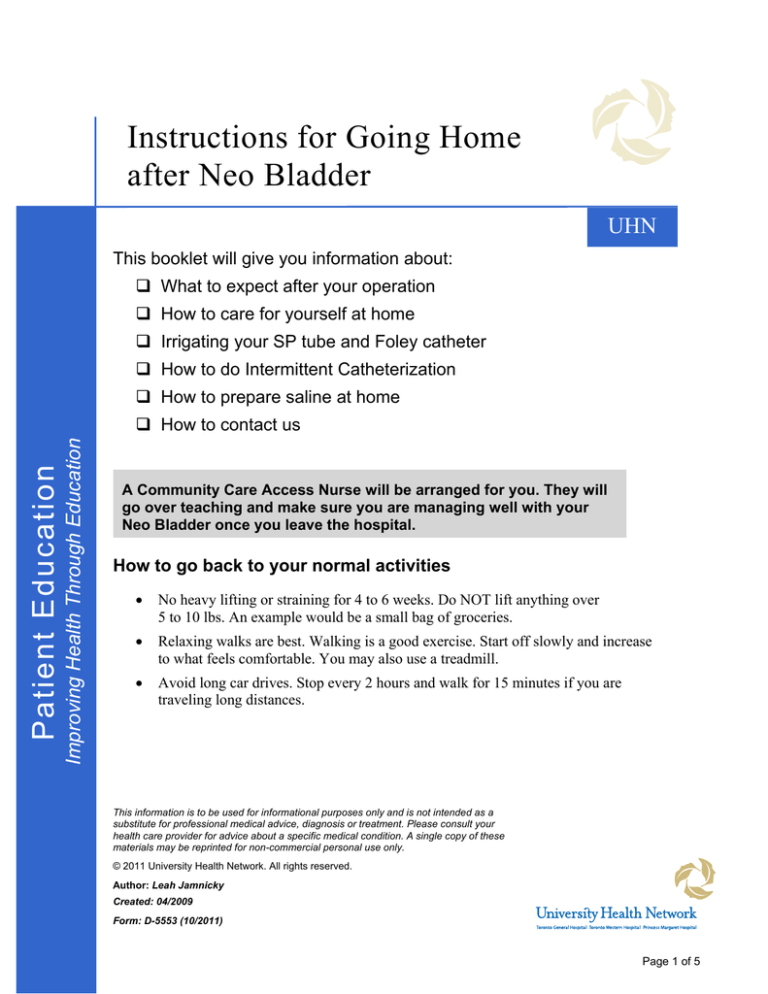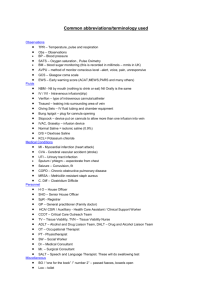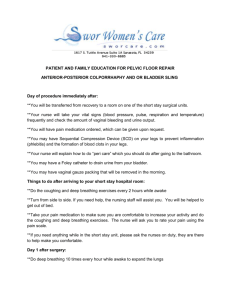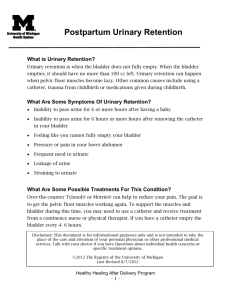
Instructions for Going Home
after Neo Bladder
UHN
This booklet will give you information about:
What to expect after your operation
How to care for yourself at home
Irrigating your SP tube and Foley catheter
How to do Intermittent Catheterization
How to prepare saline at home
Improving Health Through Education
Patient Education
How to contact us
A Community Care Access Nurse will be arranged for you. They will
go over teaching and make sure you are managing well with your
Neo Bladder once you leave the hospital.
How to go back to your normal activities
•
No heavy lifting or straining for 4 to 6 weeks. Do NOT lift anything over
5 to 10 lbs. An example would be a small bag of groceries.
•
Relaxing walks are best. Walking is a good exercise. Start off slowly and increase
to what feels comfortable. You may also use a treadmill.
•
Avoid long car drives. Stop every 2 hours and walk for 15 minutes if you are
traveling long distances.
This information is to be used for informational purposes only and is not intended as a
substitute for professional medical advice, diagnosis or treatment. Please consult your
health care provider for advice about a specific medical condition. A single copy of these
materials may be reprinted for non-commercial personal use only.
© 2011 University Health Network. All rights reserved.
Author: Leah Jamnicky
Created: 04/2009
Form: D-5553 (10/2011)
Page 1 of 5
Important
Go to your nearest emergency department if you have pain, redness or swelling in
your calf or inner thigh area.
Ways to care of your incision
•
You may shower while the clips are in place. Use mild soap. Pat the area around
the incision dry with a towel.
•
Do not put creams, lotions or powder on your incision.
•
Call your doctor, 6 A West nursing unit, or your CCAC nurse if you notice pain,
redness, swelling, drainage or tenderness in the incision area. Phone numbers are
listed on the last page of this pamphlet.
What to eat and drink
•
Drink lots of fluids. It’s best to drink at least 3 litres of fluids a day.
•
Start by eating frequent small meals at first because they are easier to digest.
•
Avoid constipation, which is caused by pain medication, by eating fruits and
vegetables for fibre. Eating foods with bran is best.
Watch for these signs and symptoms of infection
•
Pain and / or redness at the incision site.
•
Your temperature rises above 38° C, and/or you have fever, chills, or you feel
very tired.
•
Pain in your side or stomach area.
•
Foul smelling urine or cloudy urine.
Irrigating your SupraPubic (SP) tube and Foley catheter
•
Wash your hands with warm water and soap before you begin.
•
Irrigate and withdraw fluid from these tubes 3 times a day and as needed (more
often if there is a lot of mucous in your urine).
•
The SP can be done in the morning and at bedtime.
•
The foley should be done at these times and during the day.
•
When you irrigate the SP, remove the bag. Then irrigate it with 50 to 75 cc of
saline gently. Draw back gently. This tube is often difficult to withdraw fluid
from, but do not use force.
© 2011 University Health Network. All rights reserved.
Page 2 of 5
•
When you are changing from night to day bags, clean the drainage bags with mild
liquid soap and warm water. Let drip dry. You can use vinegar to clean the bags
and control odors.
•
You should have less mucous over time if you use Pharmanac.
Your Voiding Schedule
Tips when urinating: relax your pelvic floor muscles, and then contract your abdominal
wall muscles, pushing down on your lower abdomen with your hands.
Day
1st week: Urinate every 2 hours
3rd week: Urinate every 2-3 hours
8th week: Urinate every 3-4- hours
•
•
Night
Urinate every 3 hours
Urinate every 4 hours
Urinate every 6 hours
The schedule above is just an estimate of the times and goals you should try to
meet.
You may not be able to hold your urine for 3-4 hours during the day if you are
drinking lots of fluids.
Most people will have nighttime incontinence or leak urine. This does not go away and
most wear a pad at night.
3 things you can try to decrease the amount of leakage are:
1. Drink less fluid in the evening, before you go to bed.
2. Set an alarm to wake you up during the night to urinate.
3. Catheterize yourself before you go to bed to completely empty your new
bladder pouch.
• Wear a pad at night.
• Drink 3 litres of fluid during the course of the day.
Intermitent Catheterization ( IC )
IC should be done once both your SP and foley catheter are removed.
We will teach you all about IC in the Cystoscopy department after the SP and foley
catheter are removed.
IC is done once a day and as needed to clear the new bladder of mucous. How often you
do it depends on the amount of mucous you need to remove. You may find that
sometimes you need to increase IC to more than once a day.
Try and pass your urine normally before you catheterize yourself.
© 2011 University Health Network. All rights reserved.
Page 3 of 5
1. Wash your hands. Gather your supplies (such as your catheter, lubricant etc.).
2. Wash the end of the urethra really well with a mild soap without perfume (such as
Ivory soap) and water. Then wash your hands well for at least 15 seconds. If you are
an uncircumcised male, pull back the foreskin of the penis and wash.
3. Lubricate the tip of the catheter with a water-soluble gel.
4. Make yourself comfortable in a sitting position.
5. For men, hold the penis upright toward the ceiling. This creates a straighter passage
down the urethra.
For women, use a mirror to help you position and insert the catheter.
6. You will probably need to:
• Men: Slide the catheter in about 6 to 8 inches (15 - 20 cm)
• Women: Slide the catheter in about 1 to 2 inches (2.5 - 5 cm).
• Men and women: Continue to insert the catheter until you start to see urine
draining from it. When you see urine draining, slide the catheter in 1 more
inch (2.5 cm), and then stop.
© 2011 University Health Network. All rights reserved.
Page 4 of 5
7. Wait for all the urine to drain from the bladder.
• Insert 75 ml to 100 ml of saline and irrigate the neo bladder.
• Repeat the process until you see little or no mucous.
If you are having trouble inserting the catheter:
• Try taking a couple for deep breaths and exhale slowly. This helps to relax
your muscles.
• You can also try and turn the catheter as you are inserting it into the urethra.
• NEVER force the catheter.
• If you are not able not able to insert the catheter, call your doctor.
• Please do not worry if you see some pink urine when you insert or remove the
catheter. This is normal.
How to Prepare Saline at Home
Saline helps to irrigate your bladder of mucous and old blood clots. If you have been
told to make saline at home, this is how to do it. (You can also buy prepared Saline at
your local pharmacy).
There are 2 ways to prepare Saline at home:
Method One:
Mix ½ teaspoon of table salt to 1 cup boiled water.
To store: opened containers of saline must be stored in the refrigerator.
• Saline made this way may be kept for 48-73 hours in the refrigerator.
• Remove it from the refrigerator ½ hour (30 minutes) before you use it.
Method Two:
• Add 8 teaspoons of table salt to 3 litres (1 gallon) of distilled water. You can
buy distilled water at your local pharmacy.
• Pour the saline into a sterile container(s).
• Refrigerate the saline between uses.
• Keep the saline in the refrigerator for up to 4 weeks. If you cannot refrigerate
it, saline made this way may be kept for 2 weeks at room temperature.
How to Contact Us
Nursing Unit 6A West
Cystoscopy department
416-340-3521
416-340-3882
Urologists
Dr. T. Finelli
Dr. N. Fleshner
Dr. M. Jewett
Dr. A. Zlotta
416-946-2851
416-946-2899
416-946-2909
416-586-3910
© 2011 University Health Network. All rights reserved.
Page 5 of 5




